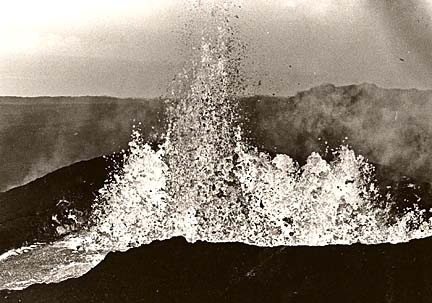

|
Mauna Loa
quakes increase
Scientists say that the rise
in activity does not necessarily
indicate an eruption is imminent
KAILUA-KONA » Scientists watching Mauna Loa swell and shake over the last year have recorded an unprecedented number of earthquakes beneath the massive volcano in the last five months.
Not enough is known about this volcano's activity to accurately forecast its next eruption, but the activity is enough to make scientists pay attention, said Jim Kauahikaua, scientist-in-charge at the Hawaiian Volcano Observatory at Hawaii Volcanoes National Park.
More than 1,350 earthquakes were recorded in the last five months, he said. During the week ending Nov. 23 alone, 105 earthquakes were located under the summit.
Scientists have seen Mauna Loa's caldera rise before and have recorded earthquakes in conjunction with previous eruptions, but Kauahikaua said the activity since this summer does not necessarily indicate an eruption is imminent.
The caldera has been swelling for two years, filling the magma reservoir after a decade of deflation.
"It has done that before," Kauahikaua said.
The recent temblors are relatively small (most less than magnitude 3.0), very deep beneath the earth's surface and concentrated under the summit and toward the southwest rift zone.
Since scientists hooked up the volcano to modern monitoring equipment in 1962, they have seen nothing like this, Kauahikaua said.
Large, shallower earthquakes preceded Mauna Loa eruptions in July 1975 and March 1984. The 1984 lava flow halted four miles from the outskirts of Hilo.
The largest volcano on earth, Mauna Loa has erupted 33 times since 1843 and its lava flows have covered 310 square miles of the island.
The longest recorded stretch between eruptions of the 13,680-foot volcano is 25 years.
Mayor Harry Kim, the county's former Civil Defense Agency administrator, said the county has procedures in place in the event of an eruption.
Kim was with the Civil Defense Agency during several eruption episodes and said while there is no such thing as a perfect plan, the county's procedures evolved from previous experience.
In addition to dozens of vents that jut out from the summit caldera like spokes from a wheel hub, Mauna Loa has two major rift zones extending northeast and southwest.
In the event the volcano spews lava to the northeast, it likely would take days or even weeks to reach Hilo.
However, Kim said, a lava flow from the southwest rift could come up "practically in the backyard" of some homes in Hawaiian Ocean View Estates, south of Kona, a "worst-case scenario" to put the emergency procedures into effect.
The residential community had fewer than 100 homes in 1970 and now includes more than 1,100, Kim said.
Because Hawaiian Ocean View Estates is laid out in a grid pattern, with each block a standard square, it would be easier to evacuate as it offers plenty of choices, Kim said.
Acting Civil Defense administrator Lanny Nakano said he also has confidence in the county's plans and works closely with scientists at the volcano observatory.
Nakano said residents should develop community plans with their homeowners associations and become better educated about the risks of living in a volcano's shadow.
hvo.wr.usgs.gov
Hawaii County Civil Defense
co.hawaii.hi.us/directory/dir_defense.htm